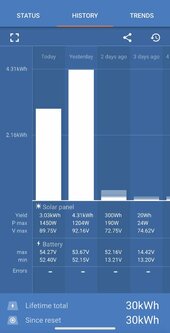TeeShizzle
New Member
Hi Everyone! Question for ya. I have a couple spots I could mount my 6 190w solar panels. One is on the roof of a shed and the other would be on a ground mount rail system. What I would like to do is place a single panel in each area temporarily and log the voltage throughout the day when I am away. Is there something I could connect to that would record the energy it sees throughout the day along with the time of the day? I hope this makes sense.
example log entry possibly:
13:00 - 21.4 volts
14:00 - 22.2 volts
15:00 - 20.9 volts
-- --
21:00 - .04 volts
This would really help me determine how and where to mount my strings.
Thank you!
Greg
example log entry possibly:
13:00 - 21.4 volts
14:00 - 22.2 volts
15:00 - 20.9 volts
-- --
21:00 - .04 volts
This would really help me determine how and where to mount my strings.
Thank you!
Greg




